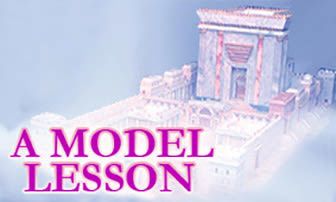
A Model Lesson
We must not cry over something that we put together over a few weeks. We must cry tonight for the loss that is close to 2,000 years."

My son-in-law, Chananya Kramer of Yeshivas Ner Israel in Baltimore, heard the following story from his mother, Mrs. Shana Kramer, who witnessed it as a child. Mrs. Kramer is the director of Torah Umesorah’s Creative Learning Pavilion. The episode happened more than 30 years ago, in Aurora, Indiana, in a summer camp for Orthodox children from midwest cities such as Cincinnati, Cleveland, Dayton, and St. Louis. It is still remembered vividly by all who saw it.
On the first day of camp, when the children and staff members had gathered in the huge social hall, the head counselor, Zvi Lerner, introduced himself and gave everyone the standard orientation about schedules, activities, and expected codes of behavior. It was all routine for those who had been to camp before, but then, with great enthusiasm, Zvi announced, "This year, we are going to build a model Temple! Our goal is to complete it by visiting day, five weeks from now.
"This will be an incredible learning experience for all of you," said Zvi passionately. "We have assigned the vessels of the Temple to different bunks. One bunk will learn about the Menorah and get a chance to build it, another will learn about the Table of Showbread and get a chance to build that, and so on.
"Our new arts-and-crafts director, Betzalel Aronovitz, is incredibly talented in construction and assembly. Betzalel spent endless hours this past winter assembling the tools, paints, and materials you will need to build this Temple. He has an ingenious construction plan that will allow us to finish this project in time, with God’s help. Learning counselors will teach each bunk the laws regarding their particular part of the Temple, and under Betzalel’s guidance we will construct a model of the building that we hope the Jewish people will be allowed to build very soon, in Jerusalem."
The campers were excited about this clever idea, but secretly they hoped it wouldn’t interfere with baseball, swimming, field day, and the camp’s well-known scavenger hunt.
With its unique focus on the Temple, camp life took on a different perspective. Every day there was talk of the various teachings of our Sages regarding the significance of offerings, the priesthood, the measurements of the vessels and chambers of the Temple, and the places where each vessel belonged. Innovative skits and nuggets of Midrashic information became daily ingredients in the children’s spiritual diet.
Slowly but surely, the various bunks began building and painting their respective vessels. An Altar was being built alongside a basketball court, the Ark was constructed near the handball court, and the Table of Showbread was assembled in the canteen. It was exciting and at times exhilarating — and baseball and volleyball didn’t suffer!
Campers and counselors were constantly involved in the construction. Finally, after four weeks, it was finished! The Temple in central Indiana gleamed and glistened to everyone’s delight. On the first day of the month of Av, it was put on display in the huge lobby of the camp’s main building.
That year, the Ninth of Av came on a Thursday, just three days before visiting day. On Wednesday afternoon at lunch, Zvi Lerner announced that the Temple would be moved outdoors and, as a way of introducing the reading of Lamentations, everyone would sit around the beautiful structure while he detailed its history and significance.
It was late afternoon. The sun was setting. The last meal before the fast was over and, wearing their sneakers, the entire camp population was gathered at the large cemented area near the swimming pool. The Temple glistened in the orange glow of sunlight that peeped through the surrounding trees. It was roped off so that no one would touch it or bump into it inadvertently.
Zvi Lerner began by detailing King David’s intense aspiration to build the Temple and God’s directive that his son, King Solomon, instead would be the one to build it. Graphically, Zvi depicted the glorious years of the Temple in Jerusalem and described how millions of Jews converged on the holy city of Jerusalem to have the opportunity to be at the Temple to come closer to God.
"But then the Jews began to feel secure in their Land, as though they would be there forever no matter what they did and they began to sin," Zvi called out. "Prophets warned them of God’s imminent wrath, but they paid no attention. Finally, Jeremiah warned Israel that God would burn and destroy the Temple, but they would not believe it. Then it happened…"
And as Zvi said those words, a huge ball of flame came hurtling through the early evening dusk, flying with unrelenting speed towards the Holy of Holies of the model structure (the innermost chamber, where the Holy Ark stood). There was a collective gasp of fright!
Unknown to the campers, a counselor had been hiding in a nearby tree with a large wad of rags that he had soaked in kerosene. At a prearranged signal from Zvi, he lit the rags and sent the fireball flying downward along a thin wire that had been tied from a branch at the top of the tree to the floor of the Holy of Holies, which had also been soaked.
The ball of flame landed in the Temple and, as a unified scream of horror rose from the campers, the structure was set ablaze. Some children cried and others shouted that the fire be put out. Within moments the entire edifice was engulfed in flames as counselors stood in front of the roped-off area, holding back any campers who attempted to go near it. The children and a number of unsuspecting staff members were distraught. Many cried openly and others turned away, unable to look at the horrible sight.
Only one part of the structure remained standing: the Western Wall, which Betzalel had cleverly soaked with water so that it would not burn.
After fifteen minutes of controlled pandemonium, Zvi Lerner called for attention and exclaimed, "Is this what we should be crying for tonight? For the pieces of wood we hammered and glued together, for the decorative painting and artwork that we did in the last few weeks? The work and effort is minuscule compared to the construction, upkeep, and service that went on in the real Temple!
"What we must cry about tonight is that we no longer feel as close to God as we did in those days, when the Temple stood in Jerusalem. We must cry because we cannot see the Priests performing their service, the Levites during their song, or the Sanhedrin during their deliberations. We must not cry over something that we put together over a few weeks. We must cry tonight for the loss that is close to 2,000 years."
Then, quietly and dutifully, everyone entered the synagogue, more prepared for the evening prayers and Lamentations than they had ever been before.
The lesson of that Ninth of Av resonates annually for those who were there and grasped its meaning.
Not everyone, though, understood the message. That evening one of the younger children asked his counselor, tearfully, "Do you think by visiting day we could have another one ready?"
That poor child didn’t understand the lesson and perhaps, sadly, after more than 1,900 years, neither do we.
(Names have been changed.)
(Excerpt from Along the Maggid’s Journey", Published by Mesorah Publications, Ltd. http://www.artscroll.com)











Tell us what you think!
Thank you for your comment!
It will be published after approval by the Editor.